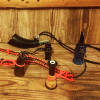It's pretty easy to make good sounds with a diaphragm call - I can make pretty sweet howls on any average turkey call. A guy just has to tend them to be sure they don't stick together before the next use. Most of his are multi-layer latex reeds, so you'll notice a layer or two, or 4, sticking together if you don't tend them well. I have somewhere just under 200 coyote calls, so it's kinda obligatory for me to own the MFK calls. I have a few from under the old TC label (Torry Cook, runs Made For Killing Calls, used to call them TC calls).
My go-to lanyard is an Ironstone Custom (Doug McCarty) fluted acrylic jack distress/yipper, a Yote Hunter (Brad Gainey) hippo ivory and red morrel closed distress, a Jared Brisby buffalo horn coaxer, and a NCK (Will Horting) double reed pronghorn antler distress call, hung with a Lights Out (John Ryan) buffalo horn howler. I used to run a Rich Cronk 1pc buffalo horn, but after Rich's passing, I've put my howler's from him up on the shelf - but they remain to be the best sounding and most efficient howlers I've ever used.


